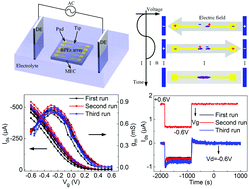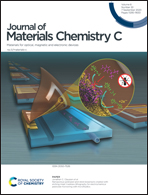Bipolar electrodeposition of organic electrochemical transistor arrays†
Abstract
Organic electrochemical transistors (OECTs) exhibit the advantages of high gain, low operation voltage, and compatibility with flexible substrates as well as with biocompatible materials. These unique characteristics promote the application of OECTs in biosensing and electrophysiological monitoring. Low-cost OECTs can be manufactured by electrochemical polymerization, and the functionality of semiconducting polymers can be tailored in a straightforward manner. Fabrication with electrochemical polymerization produces one device per process cycle, and such low-yield hinders further application in dense-array devices. In the current work, OECT arrays were prepared by bipolar electrodeposition, which was carried out three times in total. Five PEDOT:PSS films could be prepared simultaneously in each fabrication cycle. Experimental results illustrate that both the film profile and the device performance exhibited satisfactory repeatability. This research also evidenced that the resulting film properties can be tailored by meticulously tuning alternating current (AC) parameters. By constructing equivalent circuits, we demonstrate the property-tuning mechanism qualitatively based on the electrochemical impedance spectroscopy analyses. Tuning the AC frequency has proven to be more efficient than modifying the voltage amplitude for device engineering. The best AC parameters were found to be 16 Vp–p and 50 Hz. The as-prepared 15 OECTs exhibited a maximum transconductance of 0.77 ± 0.01 mS and an on/off current ratio of 182 ± 5. Time constants for switching on and switching off were 73 ± 4 ms and 217 ± 4 ms, respectively.



 Please wait while we load your content...
Please wait while we load your content...